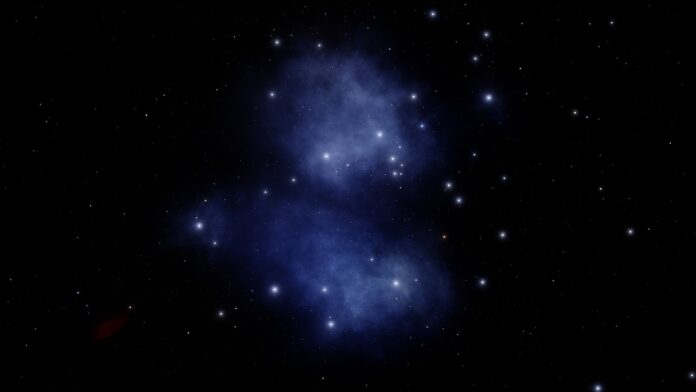From Earth, most stars appear as bright points, barely distinguishable from one another. However, in reality, celestial bodies can differ greatly in their properties, including their size. So, which star is the largest, and which is the smallest?
The Largest Star
Currently, astronomers can observe only a tiny fraction of the stars in our Universe. Therefore, the true record-holder might still be unknown. However, among the stars already discovered, the hypergiant UY Scuti is considered the largest. Its radius exceeds 1.25 billion kilometers, which is 1,700 times the radius of the Sun! Furthermore, UY Scuti pulsates, causing its radius to sometimes reach 1,900 times that of the Sun. If this giant were located at the center of our Solar System, even Jupiter would be engulfed by it. The volume of this record-breaking star is so immense that it could contain 5 billion stars the size of the Sun.
Surprisingly, the mass of UY Scuti is only 10 times that of the Sun, which means it has an extraordinarily low density. Even Earth’s air is nearly a million times denser than this hypergiant!
It should be noted that due to stellar evolution laws, UY Scuti, like other similar giants, is doomed to a rapid demise. Over the course of a few million years, it will evolve into a Wolf-Rayet star, followed by a powerful explosion known as a supernova. As a result, only a tiny neutron star will remain where the giant once was.
The Most Massive Star
As we have established, UY Scuti is a huge but relatively light star. Which star has the greatest mass? That would be R136a1, located in the Large Magellanic Cloud galaxy, 165,000 light-years away from us. The mass of R136a1 exceeds 315 times that of the Sun. However, its diameter is 50 times smaller than that of UY Scuti.
R136a1 holds several records. It is the brightest star known today, emitting 10 million times more light than the Sun. Its surface temperature reaches 56,000°C, making it the hottest star as well.
Interestingly, as early as 1924, astrophysicists realized that there was an upper limit to a star’s mass. Current calculations show that this limit is 150 solar masses. Therefore, R136a1 is more than twice this limit, meaning it theoretically should not exist! Astronomers still cannot explain this paradox. The most plausible explanation is that R136a1 formed from the merger of several large stars, each originally smaller than the 150 solar mass limit.
The Smallest Star
There is not only an upper limit but also a lower limit to a star’s mass, approximately 0.075 solar masses. If a celestial object is lighter than this limit, it will not have the conditions necessary for nuclear reactions to occur. Have astronomers found stars close to this theoretical limit?
In 2013, the star 2MASS J0523-1403 was discovered, located just 40 light-years away from us. The mass of this red dwarf is estimated to be 0.08 solar masses, and its radius does not exceed 60,000 km. Thus, 2MASS J0523-1403 is smaller (but not less massive) than Jupiter and only slightly larger than Saturn. The surface temperature of this mini-star is 2,074 K, making it the coldest star known to us. Its luminosity is almost 8,000 times less than that of the Sun, which is why such a close star was only recently discovered.
Neutron Stars
In astronomy, there are objects known as neutron stars. Their radius is only 10-20 km, yet they can exceed the Sun in mass! This means that such bodies have an incredible density, surpassing even the density of matter inside atoms. Neutron stars have an interesting structure—their entire core consists of densely packed neutrons, covered by a crust of heavy-element nuclei. In simpler terms, the material in neutron stars is compressed so much that it merges into one atom of unimaginable size. Notably, neutron stars can spin hundreds of times per second.
This raises the question: why is 2MASS J0523-1403, with a diameter of 60,000 km, considered the smallest star in the universe when neutron stars have radii of only 20 km? The fact is that a star is defined as a celestial body in which thermonuclear reactions occur. Since neutron stars do not undergo such reactions, they are not considered true stars in the strictest sense.
Interesting Facts About Stars
In our Solar System, there is only one star, but binary star systems are common in the Universe. In fact, binary systems are more common than single stars. Systems with three or more stars are rarer. The record-holder is the Castor system, which contains six stars!
Earthlings tend to consider blue light as “cooler” than red or yellow. However, in astronomy, the situation is the opposite. Blue stars have the highest temperatures, while red stars are the coldest. Brown dwarfs, which are not stars but closely resemble them, are classified separately.
Stars form from gas and dust clouds, which are created from the explosions of other stars. This leads to several generations of stars. Our Sun belongs to the third generation. No stars from the first generation have been discovered yet, and it is possible that none remain in the Universe.
The lifespan of stars depends on their mass. The largest stars live for only a few million years. The Sun is expected to last about 10 billion years. The smallest stars can live for more than 10 trillion years.
There are about 300 billion stars in our galaxy. However, there are around 2 trillion galaxies in the observable Universe! Thus, the total number of stars in the Universe is unimaginably vast.
